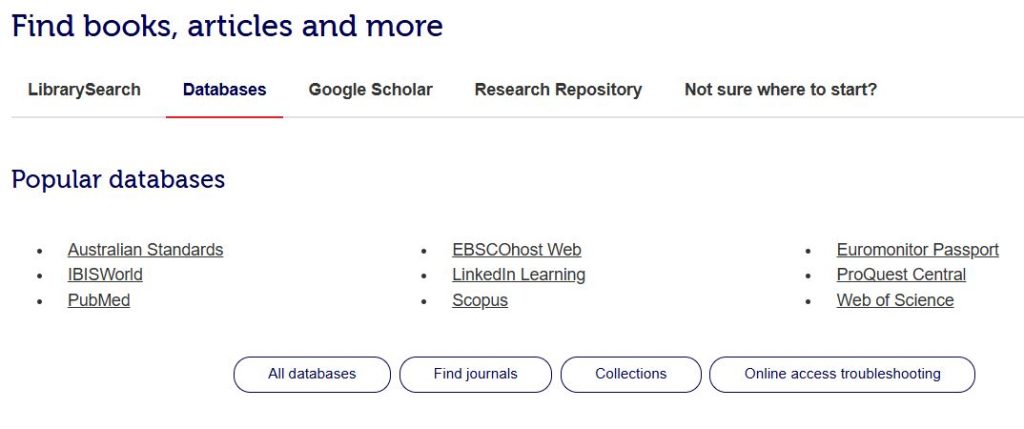Searching Library databases
Databases
While LibrarySearch is a good starting place, you will need to move beyond this to comprehensively retrieve relevant literature. As mentioned, the library subject guides include key databases for a discipline, but they can also be explored and accessed via the RMIT Library home page. There are many databases available, some of which are subject-specific, some based on format (like company reports, videos or standards) and others are multi-disciplinary, meaning they contain information across a range of topics.
Databases are excellent tools for researching journal articles, as well as other scholarly content. They often have a specialised focus – for example, by subject, resource type, or geography. You can explore the different types of databases on offer from the Library that include videos, images, theses, standards, and more.
To access the list of popular databases, select the Databases tab in the ‘Find books, articles and more’ on the Library’s homepage.

Image: Screenshot of Find books, articles and more showing the list of popular databases. RMIT University Library homepage. 16 December 2024. Copyright © 2024 RMIT University.
Watch this video for a brief introduction to Library databases.
What’s a library database? (1:56 mins)
What’s a library database? by RMIT University (YouTube). Copyright © RMIT University.
Test your knowledge
Searching databases
Like LibrarySearch, results in databases can be sorted and filtered in a variety of ways – for example, by the level of content (scholarly, peer-reviewed). Many databases will include the same functions for searching but may differ depending on the type of information the database includes.
A large database that covers a range of subject areas including business, science, health, and social sciences is ProQuest.
Watch this video to learn how to do an advanced search in the ProQuest database.
ProQuest Advanced Search (2:14 mins)
ProQuest Advanced Search by ProQuest (YouTube). Copyright © Proquest.
Finding the full article
Databases will often give you direct access to the full text online, but if you cannot see a link to the online article, try the ‘Find it’ button link. This will open a new browser window that will search all databases to which RMIT University Library has access.
If not held at RMIT
If you cannot find the article online it may be available in print, or you can request the article via the Library’s Document Delivery Service.
Activity
The activity uses the ProQuest database. You may wish to practice searching one of the databases you selected earlier, from your subject guide.
- Go to the Library homepage and select the Databases tab.
- Select ProQuest Central from the ‘Popular databases’ list.
- Note the Basic and Advanced Search options. Select Advanced Search.
- Search the database using your search query keywords and try to use a simple Boolean search, e.g. (waste water OR effluent) AND (recycling AND cities).
- Next to the search box from the drop-down menu select ‘Anywhere except full text’. Also, select options to limit to peer-reviewed articles and publication date of ‘Last 3 years’.
- Note options for Source/Document type.
- Select search.
Citation databases
Scopus and Web of Science are two large citation databases that can be important starting points for subject areas, particularly in the sciences. These databases also display citation data that enables you to track the development of a research idea forward through time.
Use this link to access the video, How to create citation overviews tutorial, (link opens in a new tab) providing instruction on Citation overview in Scopus.
The citation overview tool in Scopus displays trends for a set of documents. It shows all publications citing a specific document (or set of documents), allowing discovery of the overall impact of publications in a research areas of interest.
Watch this video to learn how to use the Web of Science Citation Report.
Web of Science: Create Citation Reports (1:57 mins)
Create Citation Reports in Web of Science by Web of Science (YouTube). Copyright © Clarivate.

